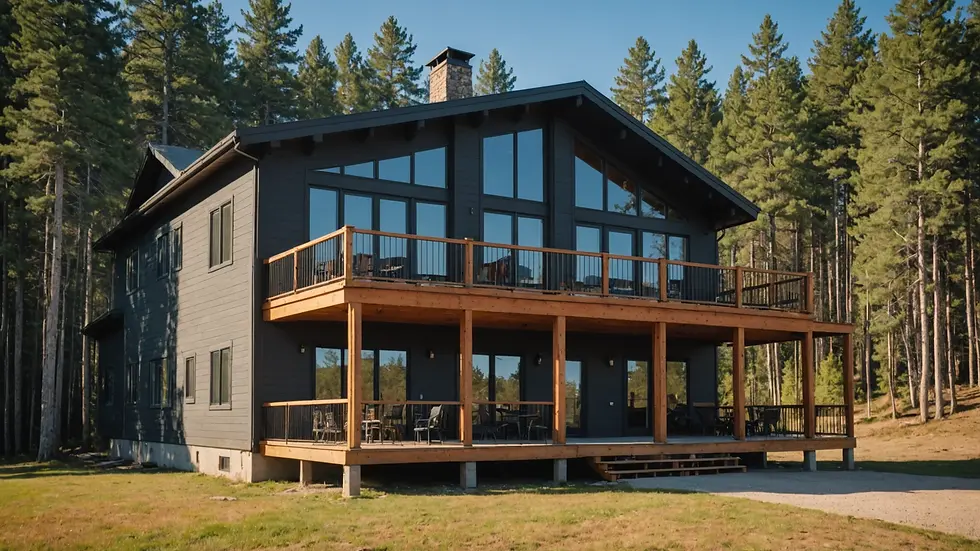Uncovering the Mysteries of the Black Hills: Exploring the Hidden Radioactive Material and Radon Gas
- Leah Venable
- Feb 3
- 3 min read
The Black Hills of South Dakota are not just another scenic destination. With their majestic views, diverse wildlife, and unique geological features, these hills draw in over 2 million visitors each year. However, hidden beneath this allure is a more complex story involving radioactive materials and radon gas. In this post, we will explore the stunning beauty of the Black Hills while revealing the geological secrets that lie below.
The Allure of the Black Hills
Every year, thousands explore the breathtaking vistas of the Black Hills. From the iconic Mount Rushmore, a monument carved into granite that attracts around 3 million visitors annually, to the mesmerizing Crazy Horse Memorial, there is much to discover. Outdoor enthusiasts can enjoy hiking, wildlife viewing, and camping in places like Custer State Park, where visitors might spot bison, elk, and diverse bird species.

Yet, the Black Hills are more than just picturesque. They are also a geological treasure. Formed over millions of years through volcanic activity and erosion, their unique granite formations and rich ecosystems play a vital role in the environment.
The Geology Behind the Beauty
At the core of the Black Hills lies a fascinating geological story. They are primarily composed of granite, supplemented by sedimentary rocks and volcanic deposits. The youngest rocks in the area date back to the late Paleozoic era, while the oldest granite formations are estimated to be over 1.7 billion years old.
The significance of these foundations extends beyond mere aesthetics. The uranium and thorium deposits derived from ancient geological processes provide critical insights into the history of the Earth. Scientists study these formations to understand the evolution of the planet and the effects of radioactivity.
Understanding Radon Gas
Radon is a colorless, odorless gas that can be hazardous to health. Formed from the decay of uranium found in the soil, rock, and water, radon is particularly prevalent in areas like the Black Hills where uranium deposits exist.
Exposure to radon is not typically harmful in short bursts, but long-term exposure can significantly increase the risk of lung cancer. The Environmental Protection Agency (EPA) states that radon is the second leading cause of lung cancer in the U.S., responsible for approximately 21,000 deaths every year.
How Radon Forms in the Black Hills
In the Black Hills, radon formation begins with uranium decay. As uranium breaks down, it releases radon gas, which can then seep through soil and rock into the air. This gas often accumulates in confined spaces, like basements or poorly ventilated homes, creating potential health hazards.
Homeowners and residents often conduct radon tests to measure gas levels. Fortunately, there are effective ways to mitigate these levels. Common methods include:
Improving ventilation by opening windows or using fans.
Sealing cracks in floors and walls.
Installing radon mitigation systems, which are designed to reduce indoor radon levels significantly.

The Importance of Testing and Mitigation
Being aware of radon is vital for anyone living in or visiting the Black Hills. Testing for radon is simple and can be done using do-it-yourself kits or by hiring a professional. The process typically involves placing a test kit in your home for a few days to measure the radon levels.
For homes with elevated radon levels, installing mitigation systems can effectively reduce the gas. It is advisable for homeowners to conduct tests periodically, as environmental changes or home modifications can alter radon levels.
By approaching radon awareness with knowledge and action, residents and visitors can enjoy the beauty of the Black Hills without compromise.
Enjoying the Black Hills Safely
Visiting the Black Hills offers a chance to connect with nature, but it is crucial to do so safely. Hiking, camping, and appreciating the scenery can all be enjoyed while keeping radon risks in mind.
Consulting official guidelines regarding radon exposure can provide valuable information for anyone spending time in the Black Hills. When one is educated on radon and actively monitors indoor environments through testing and mitigation, the experience of this captivating region becomes even more enriching.

Embracing the Beauty and Mystery of the Black Hills
The Black Hills symbolize nature's magnificence, yet they hold secrets that deepen our appreciation for their beauty. Understanding the underlying radioactive materials and the radon gas associated with them helps paint a more complete picture of this remarkable region.
While the enchantment of the Black Hills is clear, awareness of radon gas enhances safety for all. Through regular testing and proper mitigation, visitors can fully relish the breathtaking landscapes while prioritizing their health. Knowledge equips us to embrace both the beauty and the mysteries of the Black Hills.




Comments